SMU Data and Models

Steelmaking raw material prices mixed in January
Written by Brett Linton
January 30, 2025
Prices for the seven steelmaking raw materials SMU tracks moved in differing directions from December to January, according to our latest analysis.
Prices for five of the seven raw materials are less expensive than they were three months ago. Compared to prices this time last year, all but two materials have declined significantly.
Through the end of January, prices for steel scrap, iron ore, and aluminum increased month over month (m/m), while zinc, pig iron, and coking coal prices edged lower.
Table 1 shows the latest prices for each product and their changes from recent months.
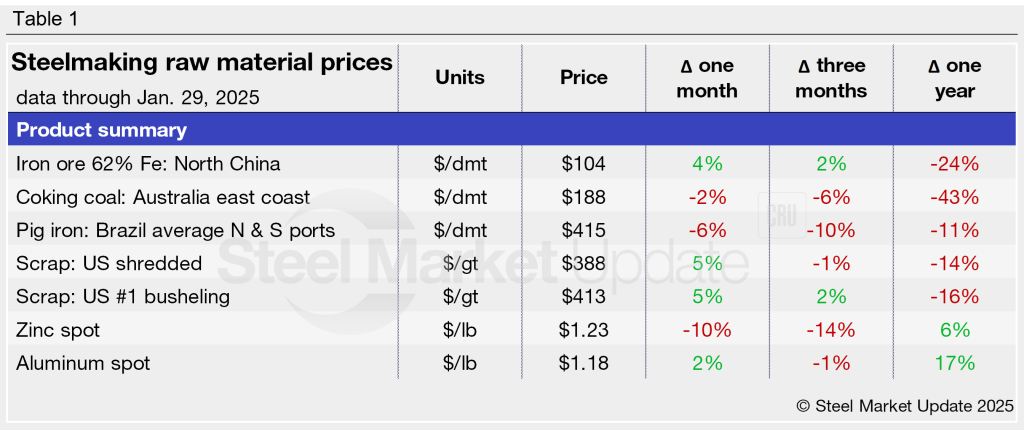
Iron ore
The import price of 62% Fe Chinese iron ore fines has remained in the $100-per-dry-metric-ton (dmt) ballpark since October. The latest weekly spot price as of Jan. 29 is at a six-week high of $104/dmt delivered North China (Figure 1). Iron ore prices are 2% higher than levels seen three months ago, yet 24% lower than prices recorded this time last year.
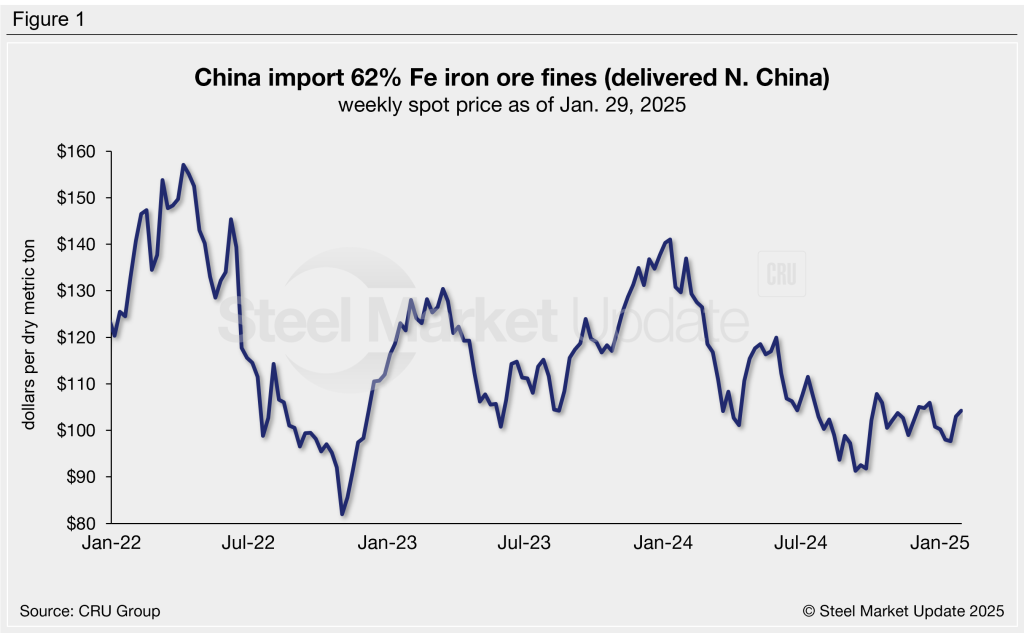
Coking coal
Prices for premium hard coking coal have trended downward for over a year now, reaching a three-year low of $182/dmt in mid-September. Prices partially recovered through October but have slid lower again since, currently at $188/dmt this week (Figure 2). Coking coal prices are 6% lower than those seen three months prior and 43% lower than they were one year ago.
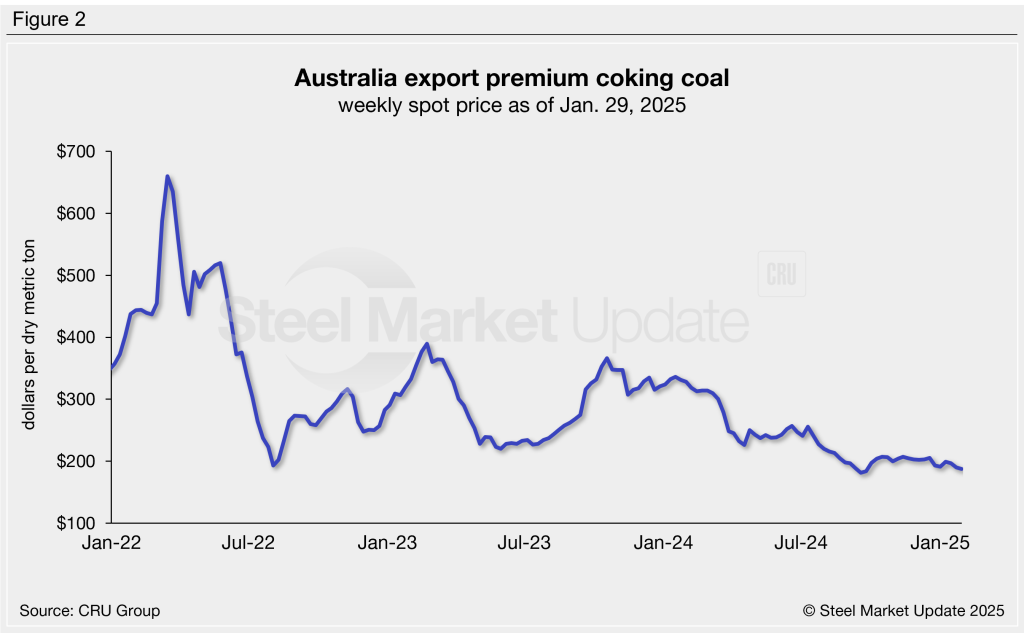
Pig iron
Following months of stability from May through October 2024, pig iron prices have trended lower since the end of last year. Prices eased 6% from December to January to a four-year low of $415/dmt (Figure 3). Pig iron prices are 11% lower than those witnessed this time last year.
Recall that pig iron prices had jumped more than 60% in April 2022 following the invasion of Ukraine by Russian forces, reaching a historic high of $975/dmt. Most of the pig iron imported to the US had come from Russia, Ukraine, and Brazil. This report uses Brazilian prices, averaging north and south port prices.
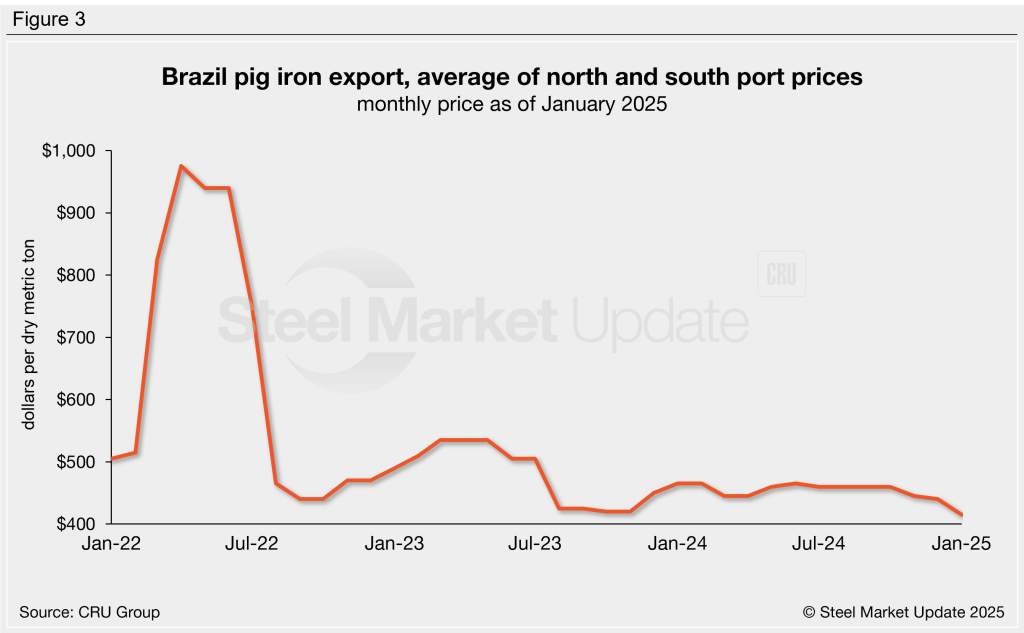
Scrap
Steel scrap prices saw a blip in January, marking the largest month-on-month (m/m) increase since December 2023. SMU’s scrap indices both recovered 5% m/m, with busheling scrap at $413 per gross ton (gt) and shredded scrap at $388/gt (Figure 4). Scrap prices are within 1-2% of those seen three months ago, but 14-16% lower than they were one year prior.
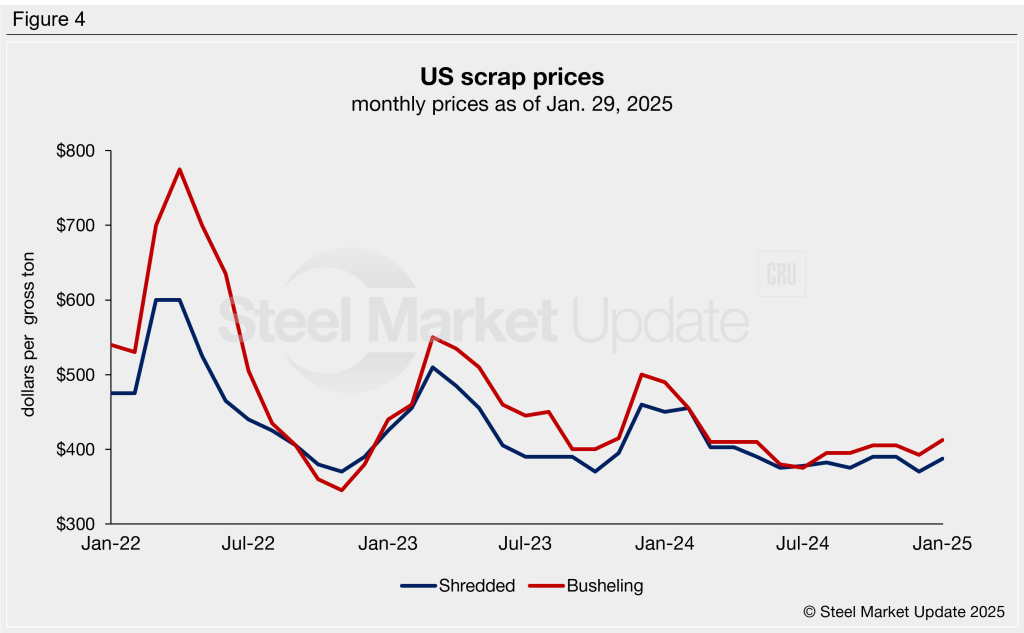
Changes in the relationship between scrap and iron ore prices offer insights into the competitiveness of integrated (blast furnace) mills, whose primary feedstock is iron ore, compared to mini-mills (electric-arc furnace), whose primary feedstock is scrap. Figure 5 compares the prices of mill raw materials over the past few years.
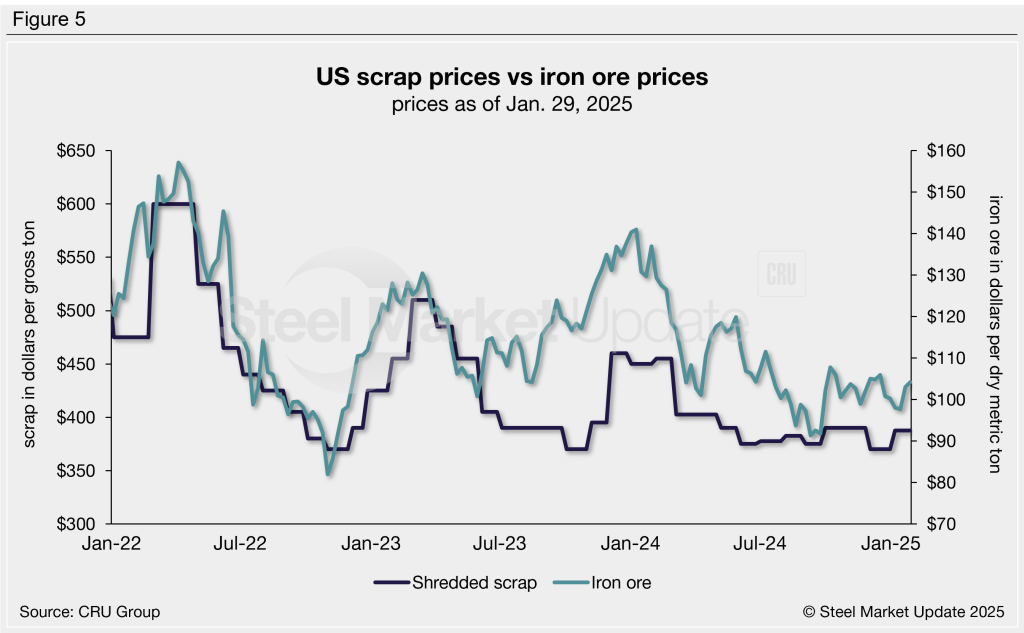
To compare these two feedstock materials, SMU divides the shredded scrap price by the iron ore price to calculate a ratio. A high ratio favors the integrated mills, a lower ratio favors the mini-mill producers. Integrated mills had mostly held the cost advantage between late 2021 through mid-2023 (Figure 6). The advantage then briefly shifted to mini-mill producers in the second half of 2023. After bouncing around in 2024, the ratio has slightly favored integrated mills since last August. The ratio has trended lower across January, registering 3.72 as of Jan. 29.
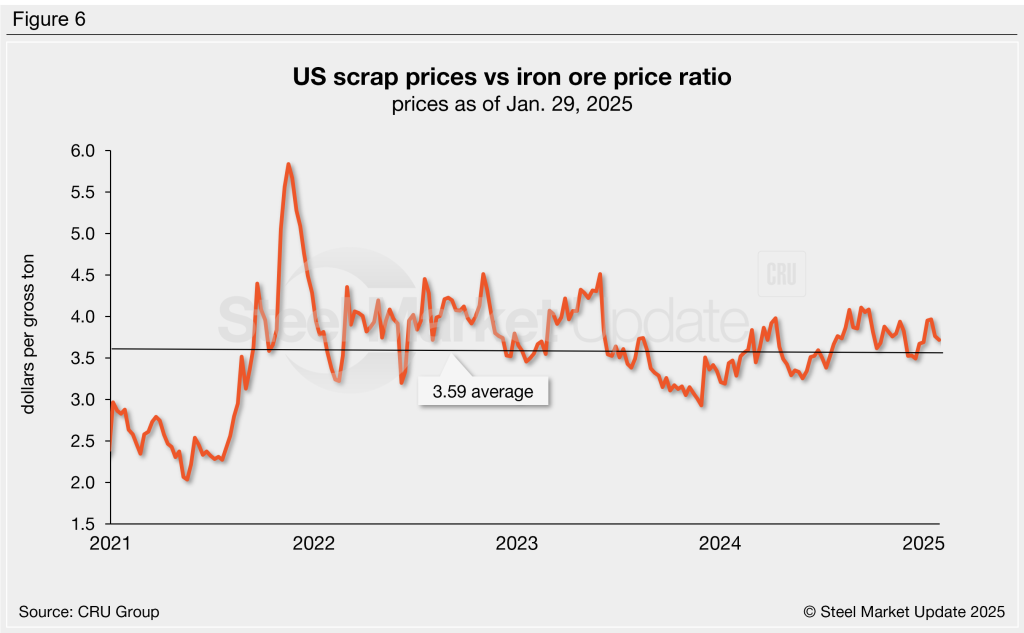
Zinc and aluminum
Zinc is used in galvanized and other coated steel products. (The surge in zinc spot prices seen through last October prompted some mills to increase their galvanized coating extras). Prices have trended lower across the last three months; the latest LME cash price for zinc is down to a four-month low of $1.23 per pound as of Jan. 29. Zinc prices are 14% lower than levels three months prior, but 6% higher than January 2024 (Figure 7).
Aluminum prices, which factor into the price of Galvalume, had been moving similarly to zinc prices but changed course in recent weeks. The latest LME cash price is $1.18/lb and has remained relatively stable since September, up 2% m/m. Aluminum prices are 1% lower than tags three months prior and 17% greater than levels seen this time last year. Note that aluminum spot prices sometimes have large swings and return to typical levels within a few days, as seen twice in Figure 7.
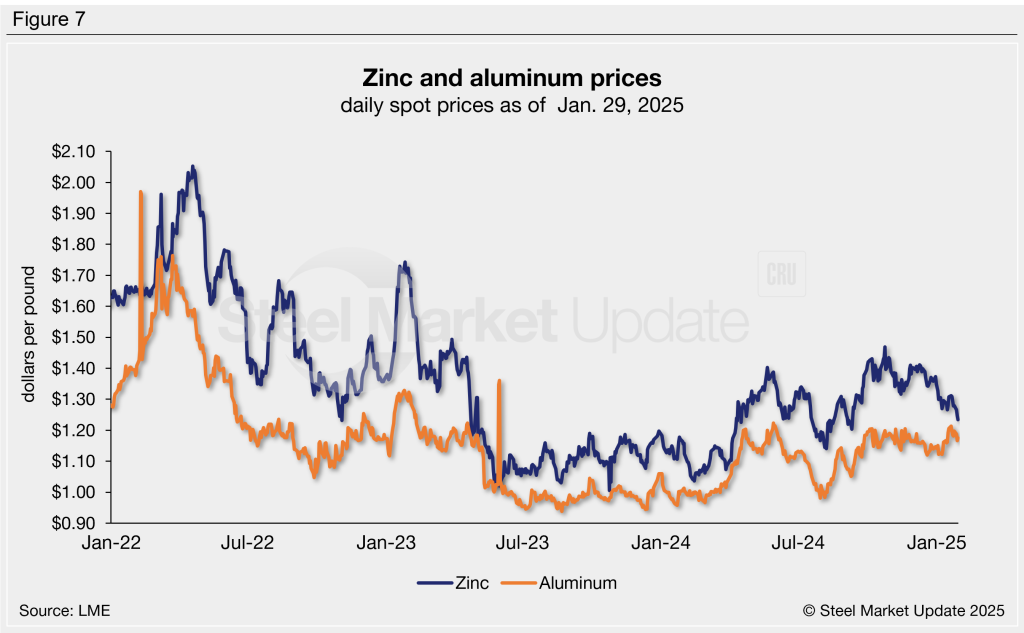

Brett Linton
Read more from Brett LintonLatest in SMU Data and Models

SMU Scrap Survey: Current, Future Sentiment Indices log declines
However, in a month plagued by tariff and economic uncertainty, both current and near-term outlooks for our scrap survey respondents remained surprisingly optimistic.

SMU’s April at a glance
SMU’s Monthly Review provides a summary of our key steel market metrics for the previous month, with the latest data updated through April 30.

SMU Survey: Steel Buyers’ Sentiment Indices see modest recovery
SMU’s Buyers’ Sentiment Indices both improved this week, reversing the decline seen two weeks ago.

SMU Survey: Sheet and plate lead times flatten out
Sheet and plate lead times held steady this week, according to buyers responding to the latest SMU market survey. This week we saw little change from mid-April levels, with just one product (Galvalume) showing any significant movement.

SMU Survey: More mills willing to deal on sheet prices, less so on plate
Nearly two thirds of the steel buyers who responded to this week’s SMU survey say domestic mills are negotiable on spot prices. This increasing flexibility marks a significant shift from the firmer stance mills held in recent months.
